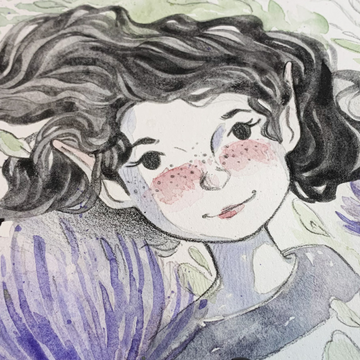Who doesn't love a good story? Whether it's the words of our favourite book or the images of cinema, we enjoy well-told stories. But literature and cinema aren't exclusive tools for storytelling. The artwork we create tells stories, too.
In this two-part series, we aim to give readers a peek into the world of visual storytelling.
Every piece of art is capable of telling a story: even modern works of art. Every type of artist and every medium can tell whatever story we need to be told. Illustration, however, is a field that excels in telling stories visually.
It is the field that focuses primarily on storytelling as its end game. Fine works of art, modern art, impressionist art all tell stories as well, but illustration makes storytelling it's the focus.
It's instinct using words to tell our stories, but how do we use art to convey the same story without words?
We know the rules of literature: characters, themes, plot, development, climax, etc. But those rules don't translate to mere images alone.
The images we see in art have to be translated and understood in a different way. There are rules that we can use to create those stories, but they aren't anything like writing a story.
An excellent artist and creative knows the building blocks needed to tell their audiences the story: without befuddling the facts, the characters, or the themes.
Telling Our Stories Well

Learning to tell our stories well isn't hard. Actually, it's just a matter of understanding how it should be done.
Some elements make a good story, and these elements can be used to visually convey the stories we see and feel in our imaginations. If we add too many elements (or too few), the story becomes unclear to everyone except ourselves.
This is why it's so important to know that when we tell a story with our art, we shouldn't make it murky or difficult for our audiences to understand what we are trying to convey.
Clarity is incredibly important when we are creating a story with our art. We need to tell those stories well.
You can use any tool, any medium, any colour, any style, and any subject: but the One Rule to rule them all is that it must be a clear direction of storytelling.
And we do that by using the building blocks and elements of visual storytelling. These building blocks are the foundation we set our stories upon.
The Elements of Visual Storytelling

There are elements for good storytelling and there are the rules for good storytelling. The following are a few of the elements that go into storytelling:
- Props that Support the Story
- Motifs
- The Subject
- Costume
- Emotion, Mood, & Posture (Body Language)
- The Setting
These are the core elements that go into creating a piece that tells its story well. There are, of course, other things that can be used to tell stories. But when we create art that is meant to convey a story, these elements prop up the story.
It enhances it, embellishes it: it makes it more believable. They are visual cues that we string together and use to point our viewers to the appropriate theme, mood, and feeling that they should infer from the artwork.
On their own, these elements are arbitrary and don't do much to tell a story—alone; but when they are used in careful and intentional juxtaposition with the other elements they begin telling a story.
If we are illustrating the story of a baby fox enjoying a lively romp in a spring day, then we would create the proper mood, setting, and props to support that story.
We wouldn't depict the fox in a dreary setting with a mopey mood. There would be spring flowers, bright daylight, with the right actions to convey the mood of the fox.
The elements of storytelling can be anything, but it's important that they all fit together cohesively and logically. A few tweaks and alterations change the story implicitly.
This is why using the elements correctly is important. We don't want our audiences to misunderstand the story.
The Subject of Visual Storytelling

The subject is rather like the main character of your favourite story. It doesn't have to be a person, however. It can be anything from a piece of nature, an animal, an element, a character, etc.
It's most likely that this subject is the focal point and theme of your painting. And all of the other elements mentioned above relate to this subject. Mood, motifs, props, emotions, and body language all work together to tell the subject's story.
In the example illustration provided in this post, viewers can see a young Elf girl in the midst of thistles.
The elements used to create the piece convey a mood and it tells us about the girl: she is young, kindly, innocent, and a little bit wild (emotion and mood).
There is wind (posture). There are motifs (the thistle, a sacred blossom to the Elves in her world). She is comfortable in her natural surroundings (setting and body language).
The freckles and little smile make her feel kind and innocent, but the fact that she is comfortable in nature gives a little bit of edge to her wild-nature. She's a character in an urban fantasy tale, which we gather from her ears and costume.
These elements weren't thrown together randomly: they were all intentionally and carefully chosen to represent her fate, story, and who she is. How we choose to construct these elements is incredibly important to how viewers see our stories.
Throwing too many things together can muddy the story and throw viewers off the mark. But this is just an example of how elements work together.
In the next post, we will take a closer look at the rules of visual storytelling: the do's and don'ts to make our visual stories even clearer.


